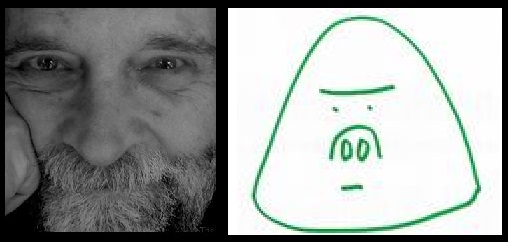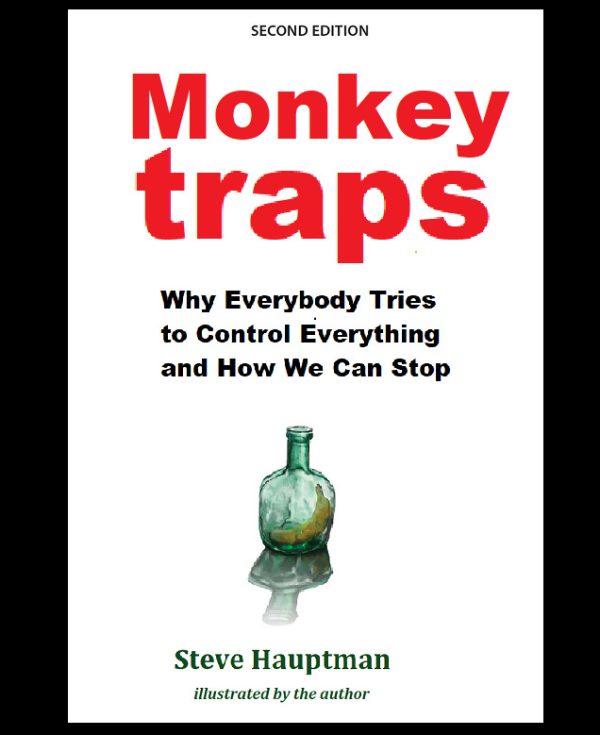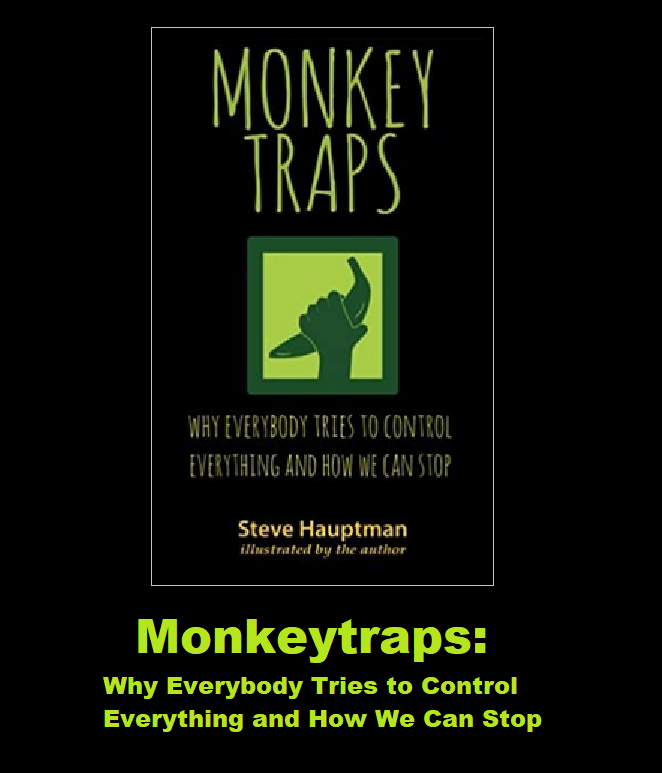*
Today begins a new series of posts excerpted from Monkeytraps in Everyday Life: A Guide for Control Addicts (in press). It’s a book about psychological monkeytraps: what they are, how they work, and how recovering addicts can learn to notice when they’ve trapped themselves by trying to control what cannot or should not be controlled.
*
 How to spot a monkeytrap
How to spot a monkeytrap
*
To see what is in front of one’s nose needs a constant struggle.
~ George Orwell
*
The first thing practicing therapy teaches you is that most people don’t know what they’re doing or why they’re doing it.
I include myself in this generalization.
It’s why I became a therapist, in fact. I needed to figure myself out.
I was sick and tired of my symptoms, which were the same ones most people bring to therapy: anxiety, depression, addictive behaviors, botched communications, frustrating relationships.
And I was tired of blundering stupidly, over and over, into the same problems that caused those symptoms.
As it turns out, none of this was my fault.
Nor is it yours.
It’s simply how we’re constructed.
We’re like icebergs. Most of us – most of our feeling and thinking and motivation — is submerged in unawareness.
During a lecture the mythologist Joseph Campbell once drew a large circle on a blackboard and then added a small notch at the top. The circle, he said, represents the total human being. The notch is the part that’s conscious.
Freud, of course, is famous for saying that the goal of psychoanalysis was to make the unconscious conscious.
Carl Jung agreed. “Until you make the unconscious conscious,” he wrote, “it will direct your life and you will call it fate.”
And T.S. Eliot noted that bad poets are usually unconscious where they ought to be conscious and conscious where they ought to be unconscious.
The same might be said of unhappy people.
So the goal of any psychotherapy worthy of the name should be to teach us what we do and why we do it.
And, often, how to stop.
*
Four laws
One way to do this is to become aware of our need for control.
That need was the subject of Monkeytraps: Why Everybody Tries to Control Everything and How We Can Stop (2015), the first in a projected six-book series.
There I defined control as the ability to dictate reality – to rearrange people, places and things according to our needs and preferences.
I described the Four Laws that had become obvious to me over twenty years of practicing psychotherapy:
-
We are all addicted to control.
-
This addiction causes most (maybe all) our emotional problems.
-
Behind this addiction lies our wish to control feelings.
-
There are better ways to manage feelings than control.
And I argued that our emotional lives are governed by these laws from birth until death, whether we realize it or not.
Monkeytraps in Everyday Life illustrates how the first three of these laws operate on a daily basis.
(The fourth law — and the three healthy alternatives to control addiction, which I call surrender, responsibility and intimacy – are discussed at length in Monkeytraps. That discussion of recovery will be expanded in the forthcoming Monkeytraps for Adult Children, Monkeytraps for Couples, Monkeytraps for Parents and Monkeytraps for Therapists.)
The title of this series comes from a method of trapping monkeys which relies on their inherent monkeyishness. Fruit is placed inside a weighted jar or bottle with a narrow neck. The monkey smells the fruit, reaches in to grab it, and traps himself by refusing to let go.
Psychological monkeytraps catch human beings in essentially the same way. They don’t so much trap us as invite us to trap ourselves.
They do this by (a) making us uncomfortable, which then (b) tempts us into trying to control something which either cannot or should not be controlled — to hold on when we should let go.
Since life is filled with discomforts, it is also filled with monkeytraps.
They range in size from the petty (like the urge to scratch a rash) to the destructive (the urge to dominate others) to the potentially fatal (the urge to numb oneself with drugs or alcohol).
Some monkeytraps are inevitable and unavoidable.
But not all.
And to the person who wants to avoid them, a bit of education can be helpful.
For example, it helps to understand how monkeytraps are constructed.
x

*
Next:
Anatomy of a monkeytrap.
* * *
*
Monkeytraps: Why Everybody Tries to Control Everything and How We Can Stop
is available here.
![Monkeytraps: Why Everybody Tries to Control Everything and How We Can Stop by [Steve Hauptman]](https://m.media-amazon.com/images/I/41K013-ukCL.jpg)






September 8th, 2020 at 3:39 am
Any suggestions or tools on how to ‘ loose control’ of sensory overload towards unhealthy foods?
September 8th, 2020 at 6:23 am
You mean cravings?
September 10th, 2020 at 7:41 am
[…] This continues a new series of posts excerpted from Monkeytraps in Everyday Life: A Guide for Control Addicts (in press). It’s a book about psychological monkeytraps: what they are, how they work, and how recovering control addicts can learn to notice when they’ve trapped themselves by trying to control what cannot or should not be controlled. Today’s post continues the book’s introduction, which began here. […]
September 14th, 2020 at 6:39 am
[…] This continues a new series of posts excerpted from Monkeytraps in Everyday Life: A Guide for Control Addicts (in press). It’s about psychological monkeytraps: what they are, how they work, and how recovering control addicts can learn to notice when they’ve trapped themselves by trying to control what cannot or should not be controlled. Read the introduction to the series here. […]
September 17th, 2020 at 8:04 am
[…] This continues a new series of posts excerpted from Monkeytraps in Everyday Life: A Guide for Control Addicts (in press). It’s a book about psychological monkeytraps: what they are, how they work, and how recovering control addicts can learn to notice when they’ve trapped themselves by trying to control what cannot or should not be controlled. Read the introduction to the series here. […]
September 21st, 2020 at 7:59 am
[…] This continues a new series of posts excerpted from Monkeytraps in Everyday Life: A Guide for Control Addicts (in press). It’s about psychological monkeytraps: what they are, how they work, and how recovering control addicts can learn to notice when they’ve trapped themselves by trying to control what cannot or should not be controlled. Read the introduction to the series here. […]
September 24th, 2020 at 8:21 am
[…] This continues a new series of posts excerpted from Monkeytraps in Everyday Life: A Guide for Control Addicts (in press). It’s about psychological monkeytraps: what they are, how they work, and how recovering control addicts can learn to notice when they’ve trapped themselves by trying to control what cannot or should not be controlled. Read the introduction to the series here. […]
September 28th, 2020 at 7:36 am
[…] This continues a new series of posts excerpted from Monkeytraps in Everyday Life: A Guide for Control Addicts (in press). It’s about psychological monkeytraps: what they are, how they work, and how recovering control addicts can learn to notice when they’ve trapped themselves by trying to control what cannot or should not be controlled. Read the introduction to the series here. […]
October 1st, 2020 at 11:55 am
[…] This continues a new series of posts excerpted from Monkeytraps in Everyday Life: A Guide for Control Addicts (in press). It’s about psychological monkeytraps: what they are, how they work, and how recovering control addicts can learn to notice when they’ve trapped themselves by trying to control what cannot or should not be controlled. Read the introduction to the series here. […]
October 5th, 2020 at 8:26 am
[…] This continues a new series of posts excerpted from Monkeytraps in Everyday Life: A Guide for Control Addicts (in press). It’s about psychological monkeytraps: what they are, how they work, and how recovering control addicts can learn to notice when they’ve trapped themselves by trying to control what cannot or should not be controlled. Read the introduction to the series here. […]
October 8th, 2020 at 3:55 pm
[…] This continues a new series of posts excerpted from Monkeytraps in Everyday Life: A Guide for Control Addicts (in press). It’s about psychological monkeytraps: what they are, how they work, and how recovering control addicts can learn to notice when they’ve trapped themselves by trying to control what cannot or should not be controlled. Read the introduction to the series here. […]
October 15th, 2020 at 9:31 am
[…] This continues a new series of posts excerpted from Monkeytraps in Everyday Life: A Guide for Control Addicts (in press). It’s about psychological monkeytraps: what they are, how they work, and how recovering control addicts can learn to notice when they’ve trapped themselves by trying to control what cannot or should not be controlled. Read the introduction to the series here. […]
October 22nd, 2020 at 9:26 am
[…] This continues a new series of posts excerpted from Monkeytraps in Everyday Life: A Guide for Control Addicts (in press). It’s about psychological monkeytraps: what they are, how they work, and how recovering control addicts can learn to notice when they’ve trapped themselves by trying to control what cannot or should not be controlled. Read the introduction to the series here. […]
October 29th, 2020 at 7:42 am
[…] This continues a new series of posts excerpted from Monkeytraps in Everyday Life: A Guide for Control Addicts (in press). It’s about psychological monkeytraps: what they are, how they work, and how recovering control addicts can learn to notice when they’ve trapped themselves by trying to control what cannot or should not be controlled. Read the introduction to the series here. […]
November 14th, 2020 at 4:59 pm
[…] This continues a new series of posts excerpted from Monkeytraps in Everyday Life: A Guide for Control Addicts (in press). It’s about psychological monkeytraps: what they are, how they work, and how recovering control addicts can learn to notice when they’ve trapped themselves by trying to control what cannot or should not be controlled. Read the introduction to the series here. […]
November 19th, 2020 at 8:04 am
[…] This continues a new series of posts excerpted from Monkeytraps in Everyday Life: A Guide for Control Addicts (in press). It’s about psychological monkeytraps: what they are, how they work, and how recovering control addicts can learn to notice when they’ve trapped themselves by trying to control what cannot or should not be controlled. Read the introduction to the series here. […]